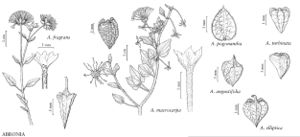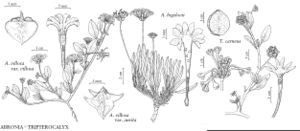Herbs, shrubs [or trees], annual or perennial. Roots fibrous to fleshy or tuberous. Stems procumbent to erect, sometimes clambering through other plants. Leaves opposite [rarely alternate], exstipulate, sessile or petiolate, pairs equal or unequal; blade linear to ovate or ± round, thin to thick and fleshy or succulent, plane or undulate, base ± symmetric to strongly unequal, margins entire or sinuate, glabrous or pubescent. Inflorescences terminal or lateral in leaf-axils, usually cymose or racemose, open or congested, bracteate; bracts distinct or connate, sometimes forming an involucre containing 1–80 flowers, when containing only 1 flower, calyxlike, sometimes brightly colored. Flowers unisexual or bisexual, sometimes cleistogamous, incomplete, showy or inconspicuous; calyx usually 5 connate sepals, varying from small and not showy to large, notably petaloid, and colorful, corollalike; corolla absent; stamens commonly as many as calyx lobes and alternate with them, varying 1–18 [–30]; filaments connate basally [or distinct]; gynoecium 1-carpellate; styles filiform; stigmas capitate, fusiform to linear, or ending in tufts of hairs; ovule 1; placentation basal. Fruits aerial (hypogeous in Okenia), accessory, radially symmetric or dorsiventrally compressed anthocarps, consisting of achene or utricle enclosed in fleshy, leathery, or woody base of calyx, sides longitudinally 5-ribbed or 10-ribbed or not ribbed, glandular or not, smooth, wrinkled, or warty, glabrous or pubescent; ribs, when present, varying from fine and linear to broad and obtuse ridges, or thick to thin wings, or rows of curved gland-tipped teeth. Seed 1; seed-coat membranaceous; embryo straight or curved; cotyledons foliaceous; endosperm scanty; perisperm abundant. x = 9 or 10?
Distribution
Primarily tropical and subtropical regions worldwide
Discussion
Genera 30, species 300 (13 genera, 88 species in the flora).
Fruits of Acleisanthes, Allionia, most Anulocaulis, Boerhavia, Cyphomeris, and many of Mirabilis produce mucilage when wetted.
Several genera are pantropical (e.g., Boerhavia, Commicarpus, Pisonia); Mirabilis jalapa, a popular ornamental, has escaped in temperate and subtropical regions of the world. Only five genera, Boerhavia, Commicarpus, Mirabilis, Phaeoptilum, and Pisonia, are indigenous to the Old World, and of these only Phaeoptilum does not occur in the New World. Mirabilis is represented in the New World by almost 60 indigenous species, whereas only one species is indigenous to the Old World. The greatest generic diversity is perhaps in the arid regions of southern North America. Boerhavia also shows considerable diversity in Australia; Commicarpus is particularly diverse in Africa and the Middle East; most Bougainvillea species are Brazilian.
Overall, there is little economic importance to the family. Mirabilis jalapa and a few species of Bougainvillea and hybrids are popular ornamentals. Others supply leaves that can be used as a vegetable and compounds that have medicinal use.
Bougainvillea glabra Choisy, a native of South America, is a woody, scandent plant grown on walls and trellises, with brilliant red-purple, orange, yellowish, or white bracts providing spectacular color. It may persist about old dwellings, and occasionally in plant dumps and gardens in warmer parts of the flora area, but it has apparently not naturalized.
Classification at the generic and suprageneric levels is problematic in Nyctaginaceae. Two great students of the family recognized differing numbers of tribes: A. Heimerl (1934c) five worldwide, and P. C. Standley (1918) six in North America alone. J. Hutchinson (1959) recognized eight tribes worldwide. Many genera are small, and G. H. M. Lawrence (1951) noted that 50% of the genera are monotypic. P. C. Standley, particularly in his earlier works (1911, 1918), recognized segregate genera, especially from widespread and variable genera such as Mirabilis and Pisonia as those are treated here. Whereas there has been a tendency among recent authors to accept a widely inclusive genus concept for Mirabilis (A. L. Bogle 1974), the segregate genera from an inclusive Boerhavia have been mostly retained (e.g., C. F. Reed 1969), although this view has not been completely accepted (F. R. Fosberg 1978).
Nyctaginaceae is believed to have been derived from Phytolaccaceae or a close common ancestor (A. Cronquist 1981), a relationship supported by J. Rodman et al. (1984) and S. R. Downie and J. Palmer (1994). Considerable anatomical work has increased our understanding of unique structural attributes in the family, and also often of its position within the Caryophyllales (e.g., H.-D. Behnke 1972, sieve-tube plastids; E. Balfour 1965, anomalous nature of secondary wood; J. W. Nowicke 1970 and J. W. Nowicke and T. J. Luikart 1971, pollen morphology; A. D. Joshi and V. S. Rao 1934, vascular anatomy of perianth).
As A. L. Bogle (1974) discussed, the term “anthocarp,” traditionally applied to the accessory fruit, has been defined in several ways and is an ambiguous term. Technically the fruit is a diclesium, as defined by A. E. Radford et al. (1974). This term has not been applied in descriptions of taxa in the family, and for these reasons the general term “fruit,” as used in the descriptions of taxa that follow, refers to the accessory fruit of this family. The side walls of the diclesium may bear sticky stipitate glands that are involved in dispersal by animals. The surfaces of diclesia in other genera may be more or less warty, and when so, secrete mucilage of unknown function when wetted. In other genera the ribs of the diclesia are expanded as hyaline wings, or the diclesium bears long winglike folds, both probably adaptations that enhance dispersal by wind.
Chromosome numbers and their significance are poorly understood in the family, and many species are estimated to have fairly high numbers. Chromosomes are small and in meiosis often tend to clump. Reported chromosome numbers range, without any obvious pattern, from 2n = 20 to 2n = 136. V. Bittrich and U. Kühn (1993) suggested that polyploidy and aneuploidy have played a significant role in the evolution of species, and that there is no clear relationship to the presumed x = 9 of the Centrospermae. For most genera, x (base number) is unknown.
Pollen grains in the Nyctaginaceae are 3- to 18-colpate, or 12- or more porate. A broad survey of pollen morphology (J. W. Nowicke 1970; J. W. Nowicke and T. J. Luikart 1971) supported A. Heimerl’s (1934c) tribal and subtribal delimitation, but because of relative uniformity it was not useful in aiding with generic delimitation within the large subtribe Nyctagininae.
R. A. Levin (2000) has demonstrated that molecular methods are successful in elucidating phylogeny within the family; her work examining relationships in Acleisanthes and Selinocarpus supports monophyly of Mirabilis, and raises some question about sectional classification in that genus.
Selected References
Lower Taxa
Illustrations
Key
| 1 | Plants shrubs or trees; flowers unisexual; stems sometimes armed with stout spines | > 2 |
| 1 | Plants usually herbs, sometimes small shrubs or suffrutescent at base; flowers bisexual; stems unarmed | > 3 |
| 2 | Fruits coriaceous, bearing numerous stipitate glands; stems often armed | Pisonia |
| 2 | Fruits fleshy, glandless; stems unarmed | Guapira |
| 3 | Stigmas linear; flowers in capitate clusters surrounded by broad bracts | > 4 |
| 3 | Stigmas capitate or peltate; flowers in cymose, racemose, umbellate or capitate clusters with or without large bracts, or borne singly | > 5 |
| 4 | Fruits with opaque, subtly veined wings that usually do not extend above and below body of fruits; receptacles slightly rounded to conic, without pedicel-like projections; maturation of flowers beginning at periphery and progressing to cen- ter of cluster, or all flowers maturing ± simultaneously | Abronia |
| 4 | Fruits with translucent, prominently veined wings that extend above and below body of fruits; receptacles flat or slightly rounded, with pedicel-like projections; maturation of flowers beginning on 1 side of cluster and progressing to other | Tripterocalyx |
| 5 | Flowers subtended by foliaceous or broad, transluscent, often connate, bracts forming an involucre | > 6 |
| 5 | Flowers ebracteate or subtended by narrow, small, distinct bracts that do not form an involucre | > 9 |
| 6 | Involucral bracts connate for at least 40% of their lengths | Mirabilis |
| 6 | Involucral bracts distinct or connate only at base | > 7 |
| 7 | Flowers 3 per cluster, highly bilaterally symmetric, blooming simultaneously and resembling single flowers; involucral bracts 3; concave surface of fruit usually bearing 2 rows of teeth, often with glands at tips; fruits dorsoven- trally compressed | Allionia |
| 7 | Flowers more than 3 per cluster, radially symmetric or slightly bilaterally symmetric, if blooming asynchronously or simultaneously, clearly representing several flowers; involucral bracts 5-20; fruit surfaces without glands; fruits radially symmetric | > 8 |
| 8 | Perianth magenta or creamy white, campanulate; flowers borne on midvein of involucral bract; fruits ellipsoid | Mirabilis |
| 8 | Perianth orange-red or yellow, funnelform; flowers borne in capitate clusters; fruits turbinate | Nyctaginia |
| 9 | Peduncles greatly elongating after anthesis, penetrating the soil; fruits hypo- geous; flowers borne singly; stems prostrate | Okenia |
| 9 | Peduncles not or only slightly elongating after anthesis, not penetrating the soil; fruits aerial; flowers usually in clusters; stems decumbent to erect | > 10 |
| 10 | Fruits with 3-5 thin, scarious, translucent wings; perianth broadly to narrowly funnelform | Acleisanthes |
| 10 | Fruits without wings or, if wings present, then thick and obscurely translucent; perianth campanulate or low domed to widely funnelform | > 11 |
| 11 | Inflorescences racemose; fruits clavate, ± gibbous on abaxial (lower) side | Cyphomeris |
| 11 | Inflorescences racemose, umbellate, cymose, or capitate, or flowers borne singly; fruits fusiform, biturbinate, oblong or narrowly ellipsoid, obovoid, clavate, or obpyramidal, not gibbous | > 12 |
| 12 | Fruits clavate, with large sticky glands; inflorescences umbellate | Commicarpus |
| 12 | Fruits biturbinate, oblong or narrowly ellipsoid, fusiform, obovoid, clavate, or obpyramidal, eglandular or glandular-puberulent; inflorescences racemose, cymose, umbellate, or capitate, or flowers borne singly | > 13 |
| 13 | Plants stout; stems erect, with sticky bands on upper internodes; fruits biturbinate or fusiform, often with equatorial wings, obscurely to prominently 10-ribbed | Anulocaulis |
| 13 | Plants slender; stems decumbent to erect, with or without sticky bands on upper internodes; fruits oblong or narrowly ellipsoid, clavate, fusiform, obovoid, or obpyramidal, without equatorial wings, prominently 5-angled or -ribbed | > 14 |
| 14 | Flowers usually borne singly, relatively large (more than 2 cm); fruits ob- long or narrowly ellipsoid | Acleisanthes |
| 14 | Flowers usually in capitate, cymose, umbellate, or racemose clusters, rarely borne singly, relatively small (usually less than 1 cm); fruits clavate, fusi- form, obovoid, or obpyramidal | Boerhavia |
"thin" is not a number.










